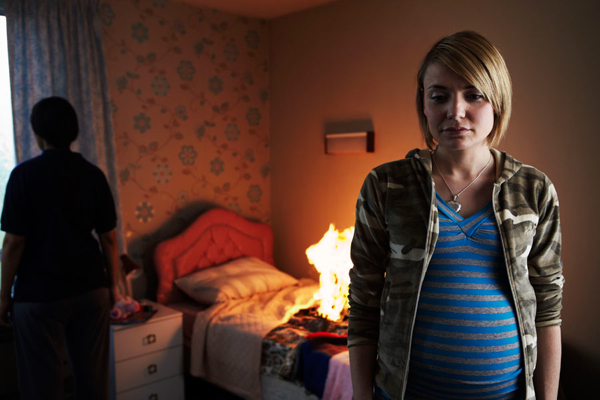Movie review by Greg Carlson
The family of British playwright Andrea Dunbar is the subject of Clio Barnard’s exceptional cinematic study “The Arbor,” an engrossing piece of creative nonfiction that combines the objectively reported and the imaginatively rearranged with a level of confidence and skill seldom applied to after-the-fact restaging associated with docufiction and docudrama. Dunbar, who at age fifteen wrote the play that shares its title with Barnard’s film, defied the odds of her class and status by soon seeing her work selected for production at the Royal Court Theatre. Dead at twenty-nine of a brain hemorrhage, the alcoholic Dunbar had three children by three different fathers.
Central to Barnard’s technique is the use of actors lip-synching to recordings of Dunbar’s relatives and affiliates (announced via an opening title card), which allows the director to light and frame moments in time with a kind of weird omnipotence only afforded by pre-recording a soundtrack. For example, in one stunning tableau, the memory of a long-ago fire is accompanied by a corresponding image in which flames leap in the shot’s background. The startling beauty of Ole Bratt Birkeland’s digital cinematography paints the environs of the run-down Bradford, Yorkshire streets with deliberate incongruity in comparison to the lives under discussion. Dennis Lim quoted Barnard saying that she “wanted to make a film that looked the opposite of how it sounded,” and the careful compositions operate in stark contrast to the wrenching tale being narrated.
Arguably, Dunbar’s daughter Lorraine eclipses her mother as the movie’s principal focus, and performer Manjinder Virk – like the other actors employed in Barnard’s bold experiment – must negotiate the challenge of constructing a “performance” tethered to a soundtrack that requires the memorization of every single original breath and pause. As the mixed-race daughter of a white mother and Pakistani father, Lorraine’s understanding of prejudice includes some devastating revelations about her treatment during childhood. As “The Arbor” continues, we learn more about Lorraine’s own demons with the same unblinking exactitude that has been applied by the filmmaker to Andrea Dunbar.
Given the unfathomable layers of pain, abuse, neglect, addiction, and illness that enveloped Dunbar during her short life and her grandson Harris in his even shorter one, Barnard cautiously resists what could easily have been rendered as emotionally manipulative in favor of almost ice-water-in-the-veins understatement. This doesn’t mean that “The Arbor” won’t bring you to your knees, but the matter-of-fact way in which the interview subjects talk about personal experiences that could lead to madness or despair says something about impoverishment and the presence and/or absence of hope.
Barnard’s directorial vision extends beyond the lip-synched interviews to a series of scenes from Dunbar’s debut theatrical drama arrestingly shot outdoors with neighborhood residents literally standing in as audience members. The theatrical snippets operate as perfect interstice to the lengthier first-person direct camera address content, demonstrating the frightening symmetry between Dunbar’s characters and the grim experiences that dominated her own day-to-day existence. Dunbar had always deliberately smudged the lines of self-portraiture and concretized chronicle, which Barnard understands and harnesses on screen to perfection.
